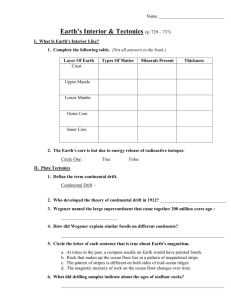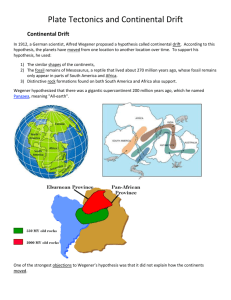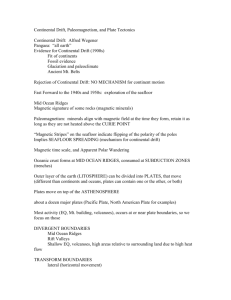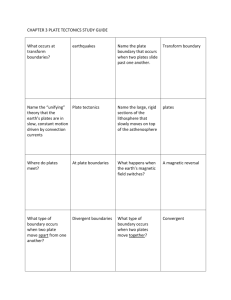Quiz 4
advertisement
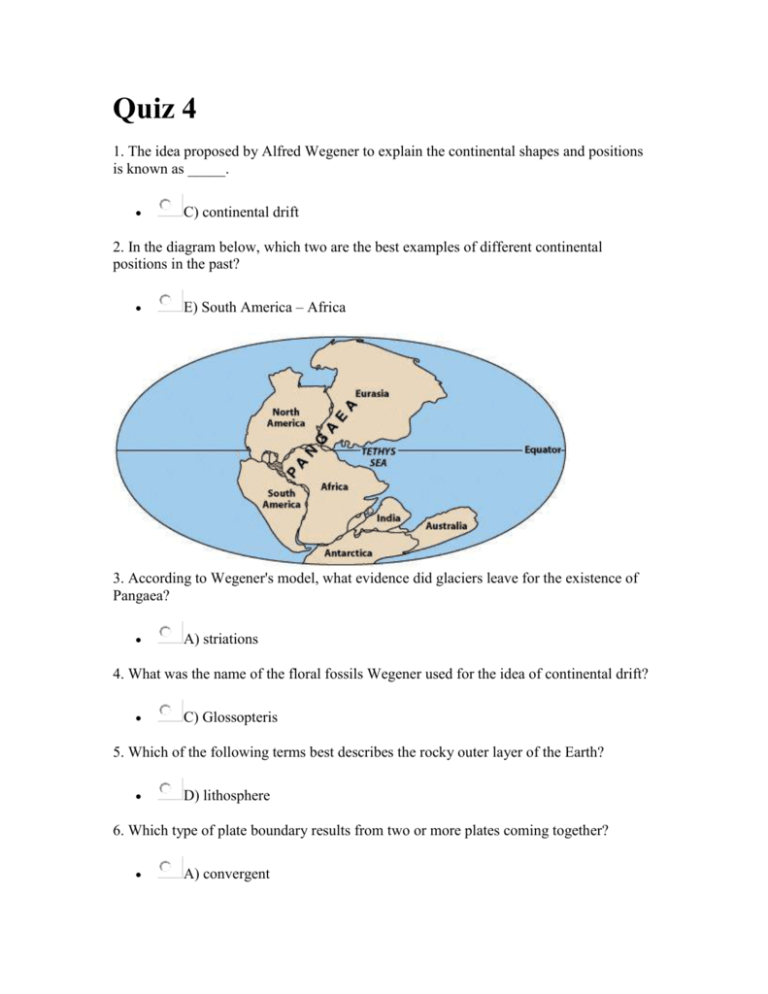
Quiz 4 1. The idea proposed by Alfred Wegener to explain the continental shapes and positions is known as _____. C) continental drift 2. In the diagram below, which two are the best examples of different continental positions in the past? E) South America – Africa 3. According to Wegener's model, what evidence did glaciers leave for the existence of Pangaea? A) striations 4. What was the name of the floral fossils Wegener used for the idea of continental drift? C) Glossopteris 5. Which of the following terms best describes the rocky outer layer of the Earth? D) lithosphere 6. Which type of plate boundary results from two or more plates coming together? A) convergent For questions 7 and 8 refer to the graph below: 7. According to the figure above, which of the following types of plate boundaries produce the deepest earthquakes? D) subduction zone boundary 8. According to the figure above, which of the following types of plate boundaries produce the shallowest earthquakes? A) transform fault boundary 9. What term best describes to driving force behind plate tectonics? C) convection For questions 10 and 11 refer to the graph below: 10. According to the diagram above, which of the following plates is all oceanic crust? C) Nasca 11. According to the diagram above, which of the following is the largest plate? A) Pacific 12. The phenomenon of the Earth's magnetic pole being in different locations in the past is known as _______. E) apparent polar wandering 13. Pangaea is the name of the supercontinent proposed by Harry Hess. False 14. The Hawaiian Islands are a result of the Pacific Plate passing over a hot spot. True 15. As rocks cool, they become denser and sink. True 16. A hypothesis is a scientific theory that has been tested. False 17. Rocks closer to the spreading centers in the oceans are older than the rocks farther away from the spreading center. False 18. Global positioning systems (GPS) are a reliable way to measure plate movements. True 19. Obduction is the processes where one plate slides under another. False 20. The rate at which plates move apart is approximately 1 to 10 cm/year. True 21. The rocky, outermost part of the Earth, comprising the upper part of the mantle and the crust, is known as the _______. LITHOSPHERE 22. The reptilian fossils that Wegener used to help prove his ideas about plates are known as _______. MESOSAURUS 23. The process in which the sea floor separates and moves in opposite directions is known as _______. SEA FLOOR SPREADING 24. The exact point where an earthquake occurs below the surface is the _______. FOCUS 25. The point on the surface directly above an earthquake occurrence is called the _______. EPICENTER 26. The process of one plate diving under another plate is known as _______. SUBDUCTION 27. How does a convergent plate boundary differ from a divergent plate boundary? B) Convergent plates move towards each other and divergent plates move away from each other. 28. How did the presence of Glossopteris fossils support Wegener's idea of continental drift? C) The fossil plant has been found in Africa, India, Australia and South America and it is unlikely that a plant could have crossed the oceans. The continents must have been together at one point for this plant to disperse. 29. How does the global distribution of earthquakes relate to the plate boundaries? A) Earthquakes will basically “mark” the boundaries of the plates, wherever an earthquake is recorded that means that there is some sort of plate interaction. 30. The following arguments: The puzzle piece argument - The complementary arrangement of the facing sides of South America and Africa is obvious. Matching geology and matching fossils - Similar plant and animal fossils are found around different continent shores, suggesting that they were once joined. Glaciers - Widespread distribution of Permo-Carboniferous glacial sediments in South America, Africa, Madagascar, Arabia, India, Antarctica and Australia was one of the major pieces of evidence for the theory of continental drift. Continuous Mountain Belts – There is evidence for mountainous chains that belong to the same chain, that are now broken and dispersed along many continents. B) Were used by Wegener to start his hypothesis of continental drift. 31. What is the difference between Plate Tectonics and Continetal Drift c) Plate Tectonics is a scientific theory and Continental Drift is a hypothesis. 32. Volcanoes are associated with which type of plate boundaries? Convergent (continental-oceanic) subduction zone


